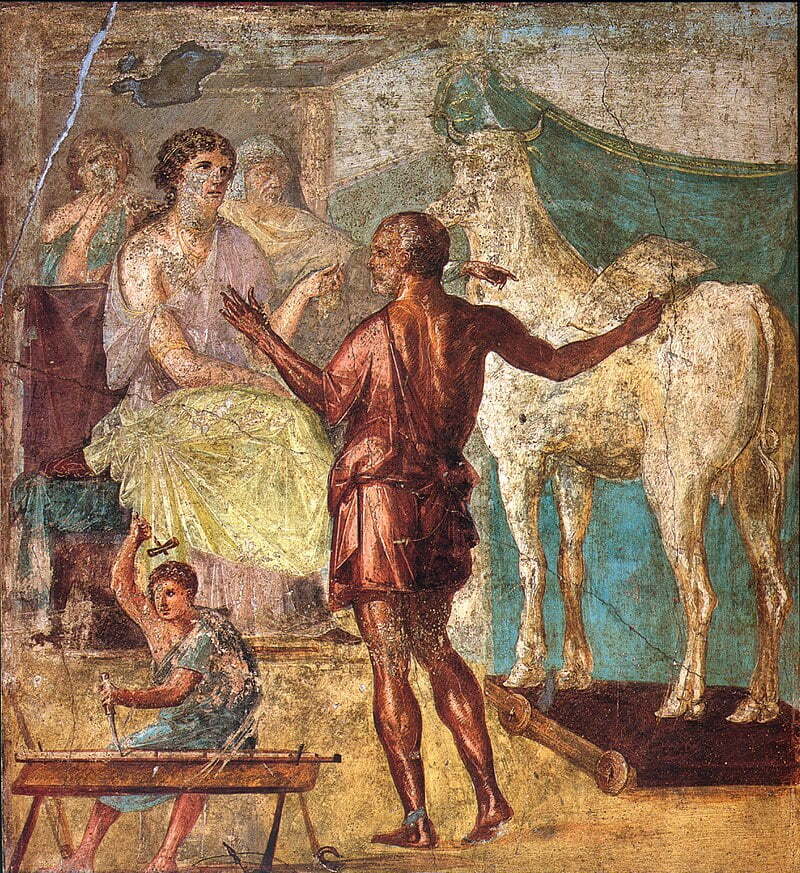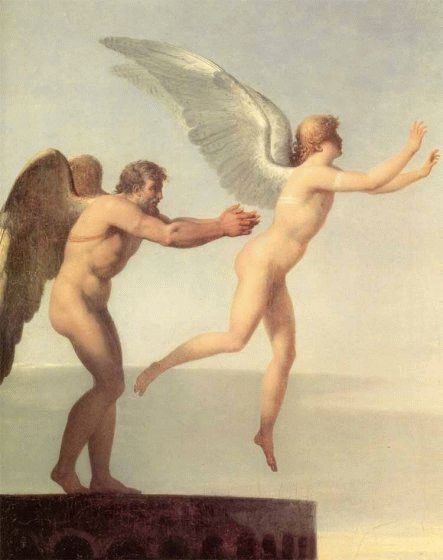Daedalus

Athenian inventor and craftsman descended from Hephaestus. He is known for his skill as an architect, sculpture, and inventor, and he produced many famous works. He was a highly respected and talented Athenian artisan descendent from the royal family of Cecrops, the mythical first king of Athens.
- Gender – Male
- Race – Human
- Occupation – Inventor/Craftsman
- Religion – Hellenic Pantheon
- Allies –
- Enemies –
- Abode/ Base of operations – Crete/Greece
- Nationality – Athenian/Greek
- Languages – Greek
- Alignment –
- Affiliation (s) – Royal House of Cecrops
- Significant others – Icarus (Son)|
Daedalus was so proud of his achievements that he could not bear the idea of a rival. His sister had placed her son Perdix under his charge to be taught the mechanical arts. He was an apt scholar and showed striking evidence of ingenuity. Walking on the seashore, he picked up the spine of a fish. Imitating it, he took a piece of iron and notched it on the edge, and thus invented the saw. He put two pieces of iron together, connecting them at one end with a rivet, and sharpening the other ends, and made a pair of compasses. Daedalus was so envious of his nephew’s accomplishments that he took an opportunity, when they were together one day on the top of the Acropolis, to push him off. For this crime, Daedalus was tried and banished.
Daedalus fled Athens and took refuge with king Minos of Crete where he eventually had a son, Icarus, with the beautiful Naucrate, a mistress-slave of the King.
Daedalus made The Labyrinth in which the Minotaur was kept and from which Theseus escaped by means of the thread of Ariadne. The labyrinth as an edifice, rather than a single path to the center and out again, and gave it numberless winding passages and turns that opened into one another, seeming to have neither beginning nor end (see labyrinth). Daedalus built it for King Minos, who needed the labyrinth to imprison his wife’s son, Asterion, the Minotaur; Ovid, in his Metamorphoses, describes Daedalus as making the Labyrinth so cunningly that he himself could barely escape it after he built it. For Minos’ wife, Pasiphae, Daedalus built a wooden cow so she could mate with a bull; Poseidon had given the bull to Minos so that he might have an excellent sacrifice, Minos had kept it for himself, and in revenge, Poseidon had inspired his wife with a lust that she only managed to assuage by hiding in the cow.
Daedalus was shut up in a tower to prevent his knowledge of the labyrinth from spreading to the public. He could not leave Crete by sea, as the king kept strict watch on all vessels, permitting none to sail without being carefully searched. Since Minos controlled the land and sea routes, Daedalus set to work to fabricate wings for himself and his young son Icarus.
He tied feathers together, from smallest to largest so as to form an increasing surface. The larger ones he secured with thread and the smaller with wax, and gave the whole a gentle curvature like the wings of a bird. When the work was finally done, the artist, waving his wings, found himself buoyed upward and hung suspended, poising himself on the beaten air. He next equipped his son in the same manner, and taught him how to fly. When both were prepared for flight, Daedalus warned Icarus not to fly too high, because the heat of the sun (Helios) would melt the wax, nor too low because the sea foam would make the wings wet and they would no longer fly. Thus the father and son flew away.
They had passed Samos, Delos and Lebynthos when the boy began to soar upward as if to reach heaven. The blazing sun softened the wax which held the feathers together and they came off. Icarus fell into the sea. His father cried, bitterly lamenting his own arts, called the land near the place where Icarus fell into the ocean Icaria in memory of his child. Daedalus arrived safely in Sicily, in the care of King Cocalus, where he built a temple to Apollo, and hung up his wings, an offering to the god.
Minos, meanwhile, searched for Daedalus by travelling from city to city asking a riddle. He presented a spiral seashell and asked for a string to be run through it. When he reached Camicus, King Cocalus, knowing Daedalus would be able to solve the riddle, privately fetched the old man to him. He tied the string to an ant which, lured by a drop of honey at one end, walked through the seashell stringing it all the way through. Minos then knew Daedalus was in the court of King Cocalus and demanded he be handed over. Cocalus managed to convince Minos to take a bath first, where Cocalus’ daughters killed Minos.
Mythological Figures: Daedalus (5E)

(Musée des Beaux-Arts et de la Dentelle, Alençon)
Mythological Figures: Daedalus (5E) | EN World | Dungeons & Dragons | Tabletop Roleplaying Games
Daedalus
Medium humanoid (human), neutral good rogue (genius) 9
Armor Class 14 (studded leather)
Hit Points 36 (8d8)
Speed 30 ft.
| STR | DEX | CON | INT | WIS | CHA |
| 14 (+2) | 15 (+2) | 10 (+0) | 20 (+5) | 14 (+2) | 8 (-1) |
Saving Throws Dex +6, Int +9
Skills History +9, Insight +10, Investigation +13, Perception +6, Religion +9, Stealth +6
Tools carpenter’s tools +8, disguise kit +4, forgery kit +4, dice set +4, mason’s tools +8
Senses passive Perception 16
Languages Common and two others
Challenge 3 (700 XP)
Background: Advisor – Master. Daedalus is frequently made to take on apprentices, training them in the ways of the mechanical arts. His subordinates obey his commands and believe what he tells them (within reason).
Cunning Action (1/turn). Daedalus can take a bonus action to take the Dash, Disengage, Help, or Hide action.
Evasion. When Daedalus is subjected to an effect that allows him to make a Dexterity saving throw to take only half damage, he instead takes no damage if he succeeds on the saving throw, and only half damage if he fails.
Fast Learner. After Daedalus has heard a creature speak for 1 minute or longer, he can mimic its manner of speaking as long as he knows the same language as the creature (allowing him to seem like he is local to a given region).
Sneak Attack (1/turn). Daedalus deals an extra 17 (5d6) damage when he hits a target with a weapon attack and has advantage on the attack roll, or when the target is within 5 feet of an ally of Daedalus that isn’t incapacitated and Daedalus doesn’t have disadvantage on the attack roll.
Tactician. Daedalus is able to use the Help action to aid an ally attack a creature as long as the target of the attack is able to see and hear Daedalus and is within 30 feet of him.
Tactician’s Insight. After Daedalus has observed or interacted with a creature for 1 minute, he learns whether or not it has higher or lower Intelligence, Wisdom, or Charisma scores than him. In addition, he learns if the target has more or fewer class levels than him. Daedalus also knows when he and the target have equal scores in one of these categories.
ACTIONS
Dagger.Melee or Ranged Weapon Attack: +6 to hit, reach 5 ft. or thrown 20/60 ft., one target. Hit: 4 (1d4+2) piercing damage.
Light Crossbow.Ranged Weapon Attack: +6 to hit, range 80/320 ft., one target. Hit: 6 (1d8+2) piercing damage.
REACTIONS
Uncanny Dodge. When an attacker Daedalus can see hits him with an attack, Daedalus can use his reaction to halve the attack’s damage against him.

 Buy me a coffee
Buy me a coffee